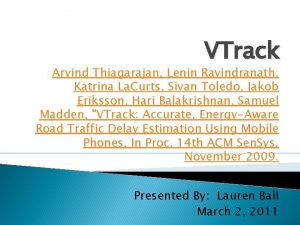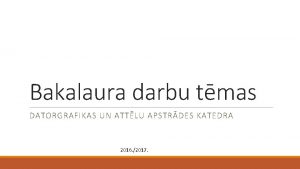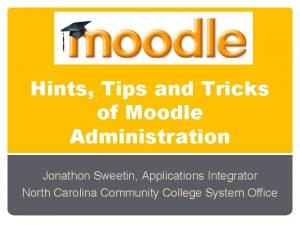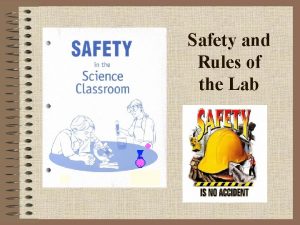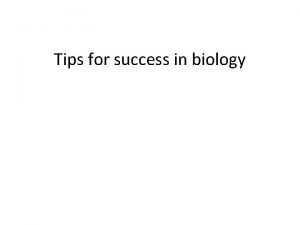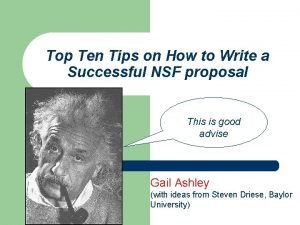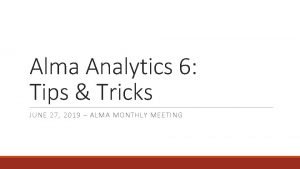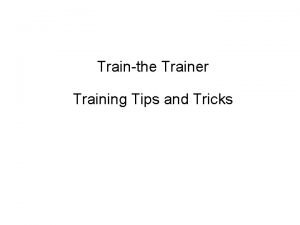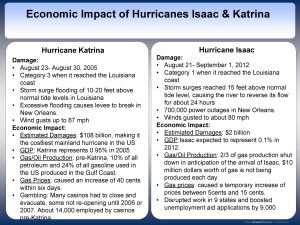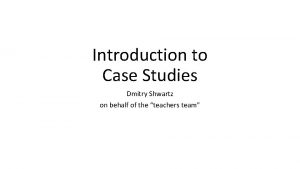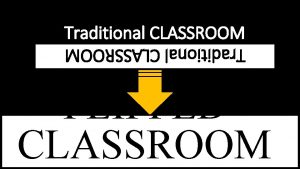Tips on managing classroom challenges Katrina Shwartz 2016





































- Slides: 37

Tips on managing classroom challenges Katrina Shwartz 2016 https: //www. kqed. org/mindshift/43049/20 -tips-to-help-deescalate-interactions-with-anxious-or-defiantstudents? fbclid=Iw. AR 1 XE 3 Cnnb 0 Z 41 u. F 4 O 3 x 7 krd. JQk. Nghuv_ 2 o. Zj. EVi. Lv. Pq. F 8 AZ 05 n. Iy. HAh. X

• 'We are 50% of every interaction with a child, so we have a lot of control over that interaction. '

anxiety • a student isn’t always anxious; • it tends to come and go based on events in their lives, so their difficulties aren’t consistent. • When we are anxious our working memory tanks, making it very difficult to recall any salient information.

• Researchers surveyed a group of first graders none of whom had any reading or math disabilities. • Those who had been diagnosed with an anxiety disorder were eight times more likely to be in the lowest achieving group in reading, and two-point-five times more likely to be in the lowest quartile in math achievement by the spring.

• Anxiety is a learning disability; it inhibits your ability to learn, • it isn’t usually recognized as a learning disability and there is almost never a plan for how to address it in the classroom. • For kids with anxiety, the ‘can’ts fluctuate, ” • When they’re calm they can. • When they’re anxious they can’t.

• Anxiety isn’t about ability, • it’s about interference, • which means that traditional rewards and consequences don’t often work with this group of learners.

• Rewards and consequences are super helpful to increase motivation for something I’m able to do, ” • But an anxious person’s brain has shut down and they aren’t able in that moment to complete the task being asked of them. • The best way to combat this tricky problem is to try to prevent anxiety triggers and build up students’ social and emotional skills to cope with the moments when anxiety sets in

• When kids are in the throes of bad behavior they have poor self-regulation skills, • often get into negative thinking cycles that they can’t stop, • have poor executive functioning, • become inflexible thinkers • and lose social skills like the ability to think about another person’s perspective. .

• kids can seem so unempathetic when teachers ask, “how do you think that made Sam feel? ” • At that moment, the student acting out has no ability to take Sam’s perspective, • but a few hours later or the next day, he might be able to show the remorse educators want to see

• Bad behavior is often connected to seeking attention, and when kids act out, they can see the results. * • “Negative attention is way easier to get and hands down easier to understand, • It’s much more efficient. • Adults tend to be unpredictable with attention when a student is doing what she is supposed to do, • but as soon as there’s a dramatic, obvious tantrum, the student has the teacher’s attention. • And negative attention is powerful -- one student can hijack a whole classroom.

• A common teacher response to low-level negative attention seeking is to ignore the student. The teacher doesn’t want to reward bad behavior. • However when you ignore someone with anxiety because their anxiety goes up • Ignoring an already anxious student can accidentally convey the message that the teacher doesn’t care about the student, and worse might escalate the situation. • Perhaps a teacher can ignore a student tapping his pencil or banging on his desk, but threatening behavior can’t be ignored. • And the student learns exactly what level of behavior he must exhibit to get attention.

TIP 1: • make positive attention compete better, ” • actively engage the most difficult student at the beginning of class saying something like, “I can’t wait to see what you think of this assignment. I’m going to check on you in 5 minutes. ”

• When you actually comes back in five minutes, validates the student’s progress, and tells her another check-in is coming in ten minutes it sets up a pattern of predictable attention for positive behavior. • And while it might seem unfair to take that extra time and care with one student, it ultimately saves instruction time when a teacher doesn’t have to deal with a tantrum that sends the student out of the room.

Tip two • Often in an attempt to form a positive relationship with a student teachers will publicly praise positive behavior. • That can backfire, especially with anxious kids who don’t want any extra attention from peers. • Private or non-verbal praise is often better. • pulling students aside at the beginning of the year to ask how you can best tell them you’re proud. Go for fact-based praise as opposed to general praise. Vague praise is easy to dismiss.

Antecedent to bad behavior • Many kids have predictable anxiety triggers like unstructured time, transitions, writing tasks, social demands or any unexpected change. • Similarly the antecedents of negative behavior are fairly predictable: unfacilitated social interactions, interaction with an authoritative adult, being asked to wait, when demands are placed, being told no, writing, and transitions.

Tip three • Teach waiting now • When you are anxious, despite your age, it’s very hard to wait. • For kids with anxiety, there a number of strategies teachers can employ. • The first is not to take any student behavior personally. • The student isn’t trying to manipulate or torture the teacher, his behavior is reflecting something going on internally. • Often a short movement break can help relieve anxiety, but not the way they are commonly given

• Waiting becomes an issue when anxious children are finished first and have to wait on their peers to catch up • Allow them to doodle or read or listen to music through earphones while waiting

• • • Leaving class doesn’t give the student a break from internal negative thoughts like “I’m fat, ” or “I’m not smart enough, ” which paralyze thinking. But a break paired with a cognitive distraction does offer respite from the “all or nothing” thinking that’s so common with anxious students. An older student might take a break and record herself reading a book out loud for a younger student with dyslexia. It’s impossible to read out loud and think another thought Other distractions could include sports trivia, sudoku or crossword puzzles. Little kids might do a Where’s Waldo or look through a Highlight magazine for the hidden picture.

Tip five • When teachers want to wrap up a task they often use a countdown. • “Silent reading time is going to be over in five minutes. ” • But counting down doesn’t support a high achieving anxious child who feels she must finish. • And it takes a lot of executive function skills and cognitive flexibility to fight the urge to keep going after the time is up. • So instead of counting down, a teacher might walk over to that student and say, let’s find a good stopping point. • She may stop a minute later than the rest of the class when she reaches the designated point, but it won’t escalate into a tug-of-war.

• Transitions are another common time for kids to act out. • Younger students often don’t want to come in from break, for example. • But when a teacher says, “Line up. breaks is over. It’s time for your spelling quiz, ” it’s no wonder the student doesn’t want to go from something he loves to something he hates.

Tip six • The teacher can give students an in-between step to make the transition more palatable. Go from break, to two minutes of coloring, to the spelling quiz. • The intermediary step gives that noncompliant student behavioral momentum. • He’s already sitting down, quiet, with pen in hand, so the jump to spelling isn’t as jarring.

• For older students, school is all about being social, but the only times students get to see their friends are in the two to five minute passing periods between classes. • Again, the transition is from something they love to something they hate, so don’t make that transition extra hard by collecting homework as they come in the door. • The toughest kids are probably already not doing well in the class, and a reminder of the homework exacerbates feelings of inadequacy.

Tip seven • One geometry teacher started playing two minute You. Tube videos about geometry as students came into class. • It got students from the hallway into the classroom without thinking negatively and her class started to run more smoothly. • She didn’t have the same interruptions she used to, which made the lost two minutes seem worth it.

Tip eight • Heartmath or Em. Wave. • A wound up student puts a sensor on his finger and calming down becomes a game. • He might start out with a picture of a black and white forest, but as he calms down (and the sensor monitors his heart rate) the colors start to pop in. • It can take as little as two to five minutes to completely calm a kid down when they can see the feedback so clearly. • it’s concrete • A student with high functioning autism might not even know what a teacher means by “calm down, ” but with the biofeedback device she can see what it means.

it’s very common for students to have trouble initiating work, persisting through work and asking for help there are strategies to help kids build the skills to get better in these areas. • In that moment the child’s working memory isn’t working, we need to find ways to bypass it until the anxiety passes.

Tip nine • One way is to let students preview the work for the day. • In the morning, we might work on the first few problems with the anxious child so she knows she can do it. • Then, when it’s time for that work later in the day, that child receives the sheet she’s already started and can go from there. • We can give students with trouble initiating the preview as homework. • Students can start at home without any pressure and continue at school. • Fight or flight is the worst when they first see it, • so try to bypass that moment and prevent a breakdown.

Tip ten • At the same time, when the teacher names the strategies a student is employing, he is helping the student build a toolbox that can be used independently. • Strategies might include asking for help start when she feels frozen • or asking to preview the homework. • For perfectionist students, difficulty starting can stem from a fear of messing up. • Give those students dry erase boards, where the mess ups can be easily erased. • It helps when teachers treat the difficulty starting as a small problem and say something like, “Looks like you’re not initiating. What strategy are you going to use? ”

Tip eleven • Some strategies to build persistence include skipping the hard ones and doing the ones a student knows first • working with a buddy, and double checking work on problems that have been completed. • Giving help in class is often a tricky balance, especially if a student is too embarrassed to ask vocally. • Instead of acting out because she can’t do the work, the student might raise her hand, pass you a note or make eye contact. • Then you have to be careful not to give too much help. • We accidentally create dependency because we help so much

• Often a teacher will notice a student becoming agitated and dysregulated and tell him to take a short walk. • the student will be better served if he can learn to monitor himself and implement strategies when he notices early signs of agitation. • “Kids have to learn how to catch themselves on the way up and calm down there • that’s when the strategies work. • But kids need to be taught how to recognize the signs.

Tip twelve • Teach kids how to do a body check. • With younger students you can describe the signs of agitation as they are happening so the student starts to recognize them. • With older students, ask them where in their body they feel anxious, for example, “in your belly? ” • Give them the data every day • This is your body on the way up. • After the groundwork has been laid you can just say “body check, please” to let a student know it’s time to check in with themselves and start using a strategy.

Tip thirteen • What educators can do is anticipate those moments and rehearse self-calming strategies when the child is calm. • Rehearse and use role play to allow children to practice their skills in a safe environment.

Tip fifteen Reframing Use data to disprove negative thinking. Writing is a common barrier for kids with anxiety, one way to begin getting students past this hurdle is to ask them how hard a task will be before they start and again after they’ve completed it. • Almost always the perception of the task is worse than the actual task. • With several weeks of data you can show students the pattern in their responses. • •

sixteen If you get off on the wrong foot with a student early in the year, try randomly being kind to the child, rather than only giving positive attention based on his or her behavior. This kind of noncontingent reinforcement helps the child to see the teacher likes him for who he is, not because he does math well or reads perfectly,

seventeen • In areas where the difficult student is competent, give her a leadership role. • Maybe let her take a younger child to the office or start an activity club. • This helps change the child’s perception of herself and also her relationship to the teacher.

eighteen • When demanding something of a student, don’t ask yes or no questions and teach kids not to ask yes or no questions. • In that scenario, someone has a 50 percent chance of being disappointed with the answer. • By changing the question, the teacher opens the door for the answer to be diffusing, rather than an escalation of defiance. • For example, if a student asks, "Can I work with Jack? " The teacher can reframe the question: "Oh, did you want to know when you could work with Jack? You can ask: When can I work with Jack. “ • The student might not like the answer, but it likely won't produce the same explosive reaction as getting an outright "no. "

nineteen • Give kids time and space. • If a student is prone to arguing, eye contact and physical proximity can escalate potential protests. • For example, if a kid is humming in an annoying way, a typical teacher move might be to make eye contact with the child and shake your head to get him to stop. • But in this situation eye-contact is non-verbally asking the child for a response, which he may be incapable of giving at that moment. • Instead, calmly walk over and put a note on his desk that says, “please stop humming. ” • Then run away and do not make eye contact with that student for a few minutes. • The initial reaction is not pleasant and you have to wait for them to deescalate before they can comply • Sometimes the mere presence of the teacher prevents that de-escalation.

twenty • Reward practice or strategy use, not performance. “ • When we shift the reinforcement to skills, I’ve noticed the skills go up and that’s what makes the difference for the kids who have mental health difficulties, • Ultimately, educators are teaching kids the skills and strategies that they can then use throughout their life when they’re anxious, so rewarding practice makes sense. • The more we can empathize with students, teaching skill building and focus on preventing challenging behavior, the smoother the classroom will run. • Often that means learning about the student in order to identify triggers and design new ways of interacting with even the most challenging students.
 Managing diversity and regulatory challenges
Managing diversity and regulatory challenges Managing the aging workforce challenges and solutions
Managing the aging workforce challenges and solutions Btech smart classes
Btech smart classes Katrina balovlenkov
Katrina balovlenkov Preventive measures of diphtheria
Preventive measures of diphtheria Themis quiz builder
Themis quiz builder Katrina butcher
Katrina butcher Optivo mutual exchange
Optivo mutual exchange Katrina flood map by address
Katrina flood map by address Katrina ramonell
Katrina ramonell Katrina hickey
Katrina hickey Katrina benet
Katrina benet Katrina amateur
Katrina amateur Hurricane katrina webquest
Hurricane katrina webquest Katrina hoffman
Katrina hoffman Hurricane katrina apush
Hurricane katrina apush Arvind thiagarajan
Arvind thiagarajan Katrina cohen-palacios
Katrina cohen-palacios Katrina prokopy
Katrina prokopy Katrina
Katrina New orleans cyclone
New orleans cyclone Katrina kang
Katrina kang Katrina gardner
Katrina gardner Katrina boločko
Katrina boločko Katrina pollard
Katrina pollard Katrina maxwell
Katrina maxwell Database design tips and tricks
Database design tips and tricks Reading sol tips
Reading sol tips Cnc programming tips
Cnc programming tips Alteryx tips and tricks
Alteryx tips and tricks Cecos moodle
Cecos moodle Animal lab safety rules
Animal lab safety rules Biology study tips
Biology study tips Prao tips åk 8
Prao tips åk 8 Top ten tips
Top ten tips Alma analytics tips and tricks
Alma analytics tips and tricks Trainthe trainer
Trainthe trainer Audrey hepburn beauty tips
Audrey hepburn beauty tips
















